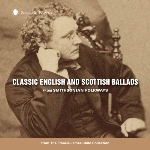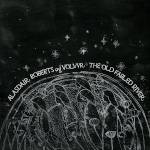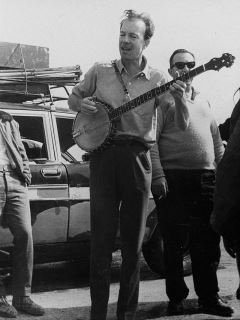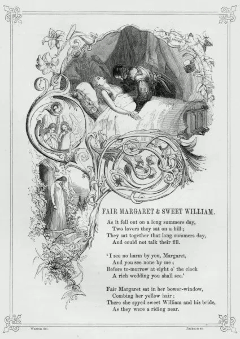FolkWorld #77 03/2022


The Child Ballads
Part 13 of FolkWorld's look at Francis James Child's English and Scottish Popular Ballads
with some ghostly appearances of the fair Lady Margaret and her sweet lover William.
Sweet William's Ghost (Lady Margaret)
Sweet William's Ghost (Child 77, Roud 50) is an English Ballad and folk song which exists in many lyrical variations and musical arrangements. Early known printings of the song include Allan Ramsay's The Tea-Table Miscellany in 1740 and Thomas Percy's Reliques of Ancient English Poetry in 1765. Percy believed that the last two stanzas of the version he published were later additions, but that the details of the story they recounted (specifically the death of Margaret upon William's grave) were original.
Sweet William's Ghost from Alasdair Roberts og Völvur's The Old Fabled River
The song is Aarne-Thompson type 365, "The Specter Bridegroom".
Synopsis
A lover, usually named William or a variant, appears as a ghost to his love, usually Margaret or a variant. He asks her to release him from his promise to marry her. She may insist that he actually marry her, but he says that he is dead; she may insist that he kiss her, but he says that one kiss would kill her; she may insist on some information about the afterlife, and he tells her some of it; he may tell her that his promise to marry her is a hellhound that will destroy him if she does not free him. In the end she always releases him from his promise, although in some versions she then dies upon his grave.
Motifs
Sir Walter Scott claimed to have been told a similar story by a woman in Shetland, and based his poem Advertisement to the Pirate upon it. He recounted the story of a woman who, finding her lover dead in London, touched his hand to free herself from the visit of his ghost.
Variants
The ballad shows the influence of Clerk Saunders and Proud Lady Margaret.
Other ballads with a similar theme include
A Canadian version of this ballad exists entitled "Lady Margaret", similar in structure to an American ballad of the same name based upon "Fair Margaret and Sweet William".
This form of ballad is also known in many Scandinavian variants (TSB A 67), although the ghost returns not for its freedom from its pledge, but because the woman's grief is harming it.
This ballad was one of 25 traditional works included in Ballads Weird and Wonderful (1912) and illustrated by Vernon Hill (sculptor).
Fair Margaret and Sweet William (Little Margaret)
Lady Margaret from Spoil The Dance's Returning Home
Shirley Collins sang this ballad as Lady Margaret and Sweet William in 1976 on her album The Power of the True Love Knot; it was also included in her anthology A Favourite Garland. She noted on the original album:
»Another song from Jean Ritchie, as sung to her by Justus Begley of Hazard, Kentucky. There are more complete versions, but none I can find explain why Sweet William passed up Lady Margaret, or how she died or how he died. But with all its ambiguities, or maybe because of them, it remains the outstanding ballad of its type where the true-lover's knot triumphs over human pride, tragedy and death.«

When it was grown to dark midnight
And all were fast asleep
In came Margaret's grimly ghost
And stood at William's feet.
Fair Margaret and Sweet William probably did the rounds as a broadside ballad before being pinned between the pages of Ramsey's Tea-Table Miscellany (1740) and later Bishop Percy's Reliques (1765).
It has been collected throughout Britain, America and Canada.«
"Fair Margaret and Sweet William" (Child 74, Roud 253) is a traditional English ballad which tells of two lovers, of whom either one or both die from heartbreak. Thomas Percy included it in his folio and said that it was quoted as early as 1611 in the Knight of the Burning Pestle. In the United States, variations of Fair Margaret have been regarded as folk song as early as 1823.
Synopsis
Fair Margaret espies the marriage procession of her lover Sweet William and another woman from her high chamber window. Depending on the variation, Margaret either commits suicide or dies of a broken heart. Her ghost then appears before Sweet William to ask him if he loves his new bride more than herself, and William replies he loves Margaret better. In the morning, William commences to search for Margaret. Upon arriving at her estate, Margaret's family shows William the corpse. In some versions, Sweet William dies of heartbreak as well, and they are buried beside each other.
Variations and related ballads
Regional and printed variations of the ballad are known by many titles, including "Lady Margaret and Sweet William", "Pretty Polly and Sweet William", "Sweet William's Bride", "Lady Margaret's Ghost", "Fair Margaret's Misfortune", and "William and Margaret", among others. Numerous variations on this basic structure can be found in folk songs throughout the British Isles and United States. Renowned folklorist Francis James Child identified three distinct versions of the lyrics, whilst Cecil Sharp collected numerous other variants, considering the ballad "Sweet William's Ghost" (Child 77) to be a slight variation on the basic plot.
Traditional versions of Fair Margaret sometimes end with a "rose-briar motif" of several stanzas describing floral growth on the lovers' neighboring graves. This motif is featured in other ballads, including "Lord Thomas and Fair Annet", "Lord Lovel", and "Barbara Allen". Fair Margaret also shares some mid-song stanzas with the murder ballad "Matty Groves" (Child ballad 81, Roud 52).
Traditional recordings

Lady Margaret (Child No. 74)
Pete Seeger, vocal and banjo
Roud 253; also known as "Fair Margaret and Sweet William", "Fair Margaret's Misfortune", "Lady Margaret's Ghost", "Pretty Polly and Sweet William"; from SF 40153, 2006
»Pete Seeger wrote,
"This ballad was one of the first I ever learned, in 1935, from the country lawyer and old-time banjo picker of Ashville, North Carolina, Bascom Lunsford.
My thanks to him. It is a medieval vignette, and the last verses describing the conversation between Lady Margaret's ghost and her false lover are as close
as we get to superstition in this LP [the Pete Seeger one]" (Seeger, notes to Folkways 2319).
As in many of these ballads, unrequited love leads to a tragic end, in this case for Lady Margaret. Child found numerous
17th-century printings of the ballad (Child 1956, II:199-203).
Pete Seeger (1919-2014) was the dean of 20th-century folksingers. He performed and lent his energies to causes he believed in for more than 70 years.
Born to a musical family, Pete grew up surrounded by music. His father was the eminent musicologist Charles Seeger and his mother Constance, a concert violinist.
In addition, his siblings Mike, Peggy, and Penny and various cousins and relatives by marriage have had successful recording careers.
He began to record for Moses Asch in 1943. In the next 40-plus years he recorded over five dozen albums for Asch. Seeger was a fine interpreter and
presenter of traditional folk song and an important composer of topical songs. One of the major figures of the folk song revival, Seeger was an important
influence on many of the other musicians who started to perform then.«
"Classic English and Scottish Ballads from Smithsonian Folkways (from The Francis James Child Collection)",
Smithsonian Folkways, 2017

In the United States, traditional Appalachian musicians such as Bascom Lamar Lunsford (1953) recorded their family versions of the ballad, as did many Ozark performers such as Almeda Riddle of Arkansas (1972). Helen Hartness Flanders collected several versions of the song throughout New England in the 1930s and 40s, which she heard performed to five different melodies.
In England, several versions were collected across the country, but the ballad appears to have largely died out before recordings could be made. Cecil Sharp collected some versions in Somerset around 1910, and Frank Kidson collected a single version in Knaresborough, Yorkshire in 1906. In Scotland, the only recording was a fragment sung by a Mabel Skelton of Arbroath to Hamish Henderson in 1985, which is available on the Tobar an Dualchais website.
Likewise, only a single version has been recorded in Ireland, that of Martin Howley of County Clare, which can be heard online courtesy of the County Clare Library.
From Wikipedia, the free encyclopedia
[Sweet_William%27s_Ghost,
Fair_Margaret_and_Sweet_William].
Wikipedia® is a registered trademark of the Wikimedia Foundation, Inc., a non-profit organization.
Text is available under the Creative Commons Attribution-ShareAlike License.
Date: February 2022.
Photo Credits:
(1) Paddy Tunney,
(2) Alasdair Roberts,
(3) Peggy Seeger,
(4) Rattle in the Stovepipe,
(5) 'Sweet William'sGhost',
(6) Spoil the Dance,
(7) Shirley Collins,
(8) Dave Arthur,
(9) Pete Seeger,
(10) 'Fair Margaret and Sweet William'
(unknown/website).
FolkWorld - Home of European Music
 Layout & Idea of FolkWorld © The Mollis - Editors of FolkWorld
Layout & Idea of FolkWorld © The Mollis - Editors of FolkWorld








Listen to Sweet William's Ghost / Lady Margaret from: Cara, Cathal McConnell, Alasdair Roberts, The Shee
Watch Sweet William's Ghost / Lady Margaret from: Cara, James Findlay & Beth Orrell, Fay Hield, Kate Rusby Lyrics (© Mainly Norfolk): Sweet William's Ghost / Lady Margaret and Sweet William






Listen to Fair Margaret and Sweet William from: Carolina Chocolate Drops, Rhiannon Giddens, Spoil the Dance, June Tabor
Watch Fair Margaret and Sweet William from: Rhiannon Giddens, Nuala Honan, Mandolin Orange , Jim Moray Lyrics (© Mainly Norfolk): Fair Margaret and Sweet William
